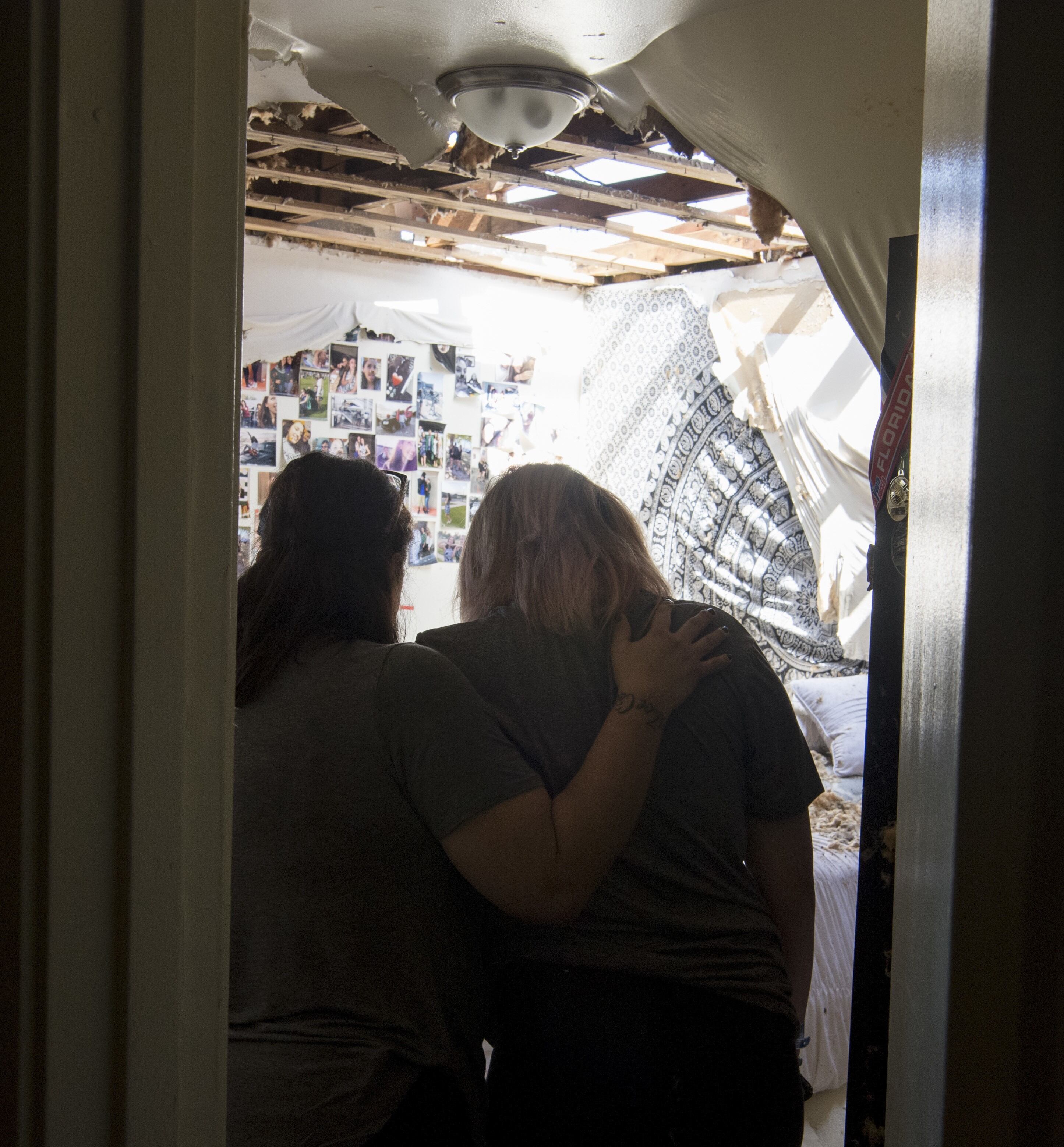As Tyndall Air Force Base begins recovering from the devastation of Hurricane Michael, it faces some hard questions about what the future will hold for the airmen, civilians and their families who were forced to evacuate.
In a Tuesday briefing with reporters at the Pentagon, Air Force officials stressed that recovering from the worst hurricane to hit a base in years, if not decades, will be a long, difficult process. While things are “exponentially” improved at Tyndall over the last few days, and some missions could be back up and running in a matter of months, they said it will likely be years before the Florida base will be back to where it was before the Category 4 storm landed its direct hit.
Brig. Gen. John Allen, the Air Force’s director of civil engineers, compared the damage to that wrought by Hurricane Katrina on Mississippi’s Keesler Air Force Base in 2005. Some of Keesler’s training missions were back up and running in six months to a year, he said, but a complete recovery took almost five years.
“I’ve been through a hurricane and a hurricane recovery before, but not on the magnitude of this,” Allen said. “You can imagine what kind of an effort lays ahead of us.”
One of the most pressing questions is how to take care of the 11,000 Tyndall personnel and families who evacuated. Most of them are in the north Florida area, but some have relocated further within the continental United States — and it’s still unclear when they might be able to start returning home.
“We’re going to have to make some serious decisions on which families come back to that base or not," said Air Force spokesman Brig. Gen. Ed Thomas. "There will be families that will be displaced from the base until we make a decision on where they’re going to PCS to, who will come back to the base. And then they will have their household goods picked up from Tyndall and moved to another location.”
The Air Force took the first steps Wednesday, when it started opening up five-hour windows to allow evacuees to return to their homes, assess the damage, and take out valuables or other household goods.

But Air Force Personnel Center commander Maj. Gen. Andrew Toth said that not much is known yet about what missions will be able to return to Tyndall — and whether some evacuees will need to be permanently moved to another installation because their jobs aren’t coming back to the base.
“That’s [part of] the determination, of where we are at in the recovery [and] what the capabilities are going to be for Tyndall in the future,” Toth said. “None of that has been concluded or determined yet.”
RELATED

Toth said airman family readiness professionals have gone to assistance centers at bases including nearby Hurlburt Field and Eglin Air Force Base, and are helping airmen and their families with their housing, financial, emergency travel, schooling and medical needs. They have so far filled 400 requests for help.
AFPC has also reached out to people who have special needs family members, or are in Wounded Warrior or Gold Star family programs, Toth said.
AFPC was also preparing to send more experts to help provide counseling, financial assistance and help with school-age children, Toth said. And relocation experts will help provide on-site counseling and assistance to both uniformed military and civilians if they need help moving.
Toth also said airmen who had upcoming deployments are being handled on a case-by-case basis to see if they still want to go or if they need to stay behind to handle hurricane recovery efforts for themselves or their families.
All of the more than 860 housing units on base will need new roofs, Thomas said. Some had damage to their siding or windows, or sustained water damage. Many are lacking utilities, he said, which will likely result in mold in a matter of days.
But Thomas said it’s unlikely large amounts of temporary housing units will be needed at Tyndall.
The Air Force has already brought in RED HORSE, or Rapid Engineer Deployable Heavy Operational Repair Squadron Engineer, airmen, and is bringing in a Prime Base Engineer Emergency Force, or Prime BEEF, unit to help with the damage assessment and recovery, Allen said.
Those engineers are expected to find widespread damage, especially on the flightline, which took the brunt of the storm.
A skeleton crew of about 400 airmen are now at Tyndall to lead the recovery effort.
AIRCRAFT STILL IN WRECKED HANGARS
Thomas said that none of the F-22s or other unflyable aircraft that had to be left behind at Tyndall have been destroyed. They generally look like they’re in good shape, he said — better than some of the hangars housing them, some of which took catastrophic damage in the storm.
Many hangar doors were ripped open, and falling debris created dings or more significant damage to the aircraft. This is especially troublesome for F-22s, which have a sensitive — and expensive — stealth coating.
Even removing the aircraft from the crippled hangars will be extremely complicated, given the extent of the damage and the amount of debris that needs to be removed. Several sustained significant roof damage, with fallen debris and spars blocking the entrances, and their structural stability remains questionable.
But while the damaged aircraft still need to be safely removed and examined more thoroughly by maintenance experts, officials are sounding increasingly confident that they will fly again.
“We’re not dealing with destroyed aircraft here,” Thomas said. “You saw the images of an F-15 static [display aircraft] flipped over, nose missing. That’s not the condition of these aircraft. All of these aircraft are all upright, with all of their noses, and their tails, and their wheels, and their wings and their vertical stabilizers in those hangars.”
The Air Force is still refusing to say how many F-22s remained at Tyndall, citing operational security reasons. It had 55 Raptors before the storm hit, most of which were flown to locations such as Wright-Patterson Air Force Base in Ohio and then to Joint Base Langley-Eustis in Virginia, which has its own F-22 wing and maintainers.

The Air Force is also expecting to erect five to seven temporary hangars, which could hold two F-22s apiece. But the officials said that doesn’t necessarily mean 14 F-22s remain, because the hangars will also hold other damaged air frames.
BASES RESPOND
Units from Air Force bases around the country are responding to help out with the Tyndall recovery effort
Col. Justin Niederer, commander of the 821st Contingency Response Group from Travis Air Force Base in California, arrived to Tyndall just after sunrise Friday morning. His group is responsible for assessing damage and bringing much-needed equipment, supplies and personnel for the rebuilding of the base in the aftermath of the hurricane, and it had significant experience responding to hurricanes Irma and Maria last year.
“Initially, on the first C-17, we assessed the airfield and made sure it was safe to bring in a second aircraft and the follow-on body, which includes aerial porter personnel to move cargo onto and off the airfield, maintenance to take care of any small aircraft issues that arise and a mobile command and control team that allows us to communicate back to higher headquarters,” Niederer said in a Tuesday interview.
The 821st has also been sweeping up and clearing debris to ensure airmen coming back to Tyndall to retrieve supplies are safe to maneuver through the base.
“Most facilities are damaged beyond repair and most aren’t safe to enter," Niederer said. “On the day of arrival it was quite a devastated environment: trees cut in half, no power, no food, no fuel, no water. But things have improved gradually over time. We actually got our first showers yesterday in five days on the ground, but there’s a lot of things that still have to be done.”
The airmen had to use a portable shower system, because the water on base is still not deemed safe to use.
“There was no source of clean water for us to acquire. … We haven’t been able to establish that,” Niederer said. “The water situation on base is kind of intermittent.”
Medical and bioenvironmental engineers have been testing the water for safety every day, but there is still no safe water for showers and no potable water for consumption.
There were 93 people who rode out the storm on Tyndall who have been relieved and sent off-base to get some nights of rest in hotels. Those airmen were assigned to stay behind to assess damage and help reopen the base when the hurricane was still expected to hit as a Category 2 storm. However, it hit as Category 4.
Niederer couldn’t say which type of aircraft were left behind on base, but said that some aircraft are still on location and expected to be assessed, fixed and flown out eventually.
“There are some air assets that were left behind on base that need to be recovered as well, and get in the air to fly to another installation,” Niederer said. “They were undergoing maintenance and were unable to depart the airport safely prior to the storm.”
Airmen on base are still working on restoring power, but generators are in place to power the recover effort, such as providing air conditioning to dry out facilities and prevent long-term damage.
“Base personnel are working on setting up generators, trying to find out which facilities may still be usable to clean them up enough and protect them from future rain storms, like putting tarps on roofs and then getting generator power onto them if possible to get air conditioning running to dry the facilities out," Niederer said. “So there’s a lot of projects ongoing as we speak. They’re clearing debris as we speak.”
Niederer said that all the equipment from Air Mobility Command needed to set up a bed-down location has arrived, to include tents, generators, latrines and other temporary infrastructure to support personnel.
“The primary effort right now … is getting the bed-down location set so we can bring in more engineers and specialists to help the base move along in this process to recover. Because of the damage to facilities, they’re not safe for personnel to work on,” Niederer said.
Stephen Losey is the air warfare reporter for Defense News. He previously covered leadership and personnel issues at Air Force Times, and the Pentagon, special operations and air warfare at Military.com. He has traveled to the Middle East to cover U.S. Air Force operations.
Kyle Rempfer was an editor and reporter who has covered combat operations, criminal cases, foreign military assistance and training accidents. Before entering journalism, Kyle served in U.S. Air Force Special Tactics and deployed in 2014 to Paktika Province, Afghanistan, and Baghdad, Iraq.





